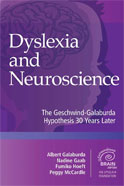Dyslexia and Neuroscience The Geschwind-Galaburda Hypothesis 30 Years Later

Author: Albert Galaburda, M.D., Nadine Gaab, Ph.D., Fumiko Hoeft, M.D., Ph.D., Peggy McCardle, Ph.D., M.P.H.
Affiliation:
Publisher: Brookes Publishing
Publication Date: 2018
ISBN 10: 1681252252
ISBN 13: 9781681252254
eISBN: 9781681252636
Edition: 1st
Affiliation:
Publisher: Brookes Publishing
Publication Date: 2018
ISBN 10: 1681252252
ISBN 13: 9781681252254
eISBN: 9781681252636
Edition: 1st
Description:
Thirty years ago, the groundbreaking Geschwind-Galaburda hypothesis defined the field of dyslexia, revealing and analyzing the complex associations among brain development, hormones, immune activity, and brain lateralization. This important volume revisits the hypothesis three decades later and explores key questions: What have we learned since then, and what still needs to be investigated?
Based on presentations from the 2016 Extraordinary Brain Symposium—and co-edited by one of the authors of the original hypothesis—this book synthesizes current dyslexia findings from more than 30 top researchers and practitioners. The contributors share diverse perspectives, concerns, challenges, and solutions, with brief jargon-free summaries at the beginning of each chapter to make the book accessible to a wider audience. Each chapter also points to research gaps and remaining questions to help shape future innovations from the next generation of researchers. A landmark addition to the literature on dyslexia and neuroscience, this forward-thinking volume should be on the shelf of every researcher and graduate student whose work focuses on neuroscience and dyslexia. Thirty years ago, the groundbreaking Geschwind-Galaburda hypothesis defined the field of dyslexia, revealing and analyzing the complex associations among brain development, hormones, immune activity, and brain lateralization. This important volume revisits the hypothesis three decades later and explores key questions: What have we learned since then, and what still needs to be investigated?
Based on presentations from the 2016 Extraordinary Brain Symposium—and co-edited by one of the authors of the original hypothesis—this book synthesizes current dyslexia findings from more than 30 top researchers and practitioners. The contributors share diverse perspectives, concerns, challenges, and solutions, with brief jargon-free summaries at the beginning of each chapter to make the book accessible to a wider audience. Each chapter also points to research gaps and remaining questions to help shape future innovations from the next generation of researchers. A landmark addition to the literature on dyslexia and neuroscience, this forward-thinking volume should be on the shelf of every researcher and graduate student whose work focuses on neuroscience and dyslexia.
Related Titles
